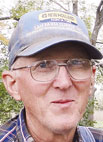
Growing up in Lockwood, Mo., about a mile from his current farmstead, Charles Obert was deeply frustrated by his father’s refusal to buy exotic animals. Instead his father ran a dairy and raised chickens and hogs for personal use.
Charles and Phyllis bought their farm in 1986 while their son, Danny, was still in high school. They ran a cattle operation, first for wintering Holstein calves and later changing to feeding out calves until butchering. Because Phyllis ran a seamstress business in town, she refused to move to the country. The family stayed in town where Charles continued with his construction business. Not long ago someone asked if he still remodeled. He just shook his head and said, “No, I threw my hammer away.”
The real bison story starts in 2001 when Charles asked Danny if he wanted to go to a bison auction, “just to look.” At the time bison calves were selling for less than domesticated calves and Charles came home with three little bison bulls. Heifers soon followed. The original bulls weighed about 350 pounds. and were, “as wild as deer.” One of those is now a massive bull weighing about 1,800 pounds that eagerly eats feed cubes out of Charles and Danny’s hands.
The farmstead is small, only about 20 acres, but the Oberts maximize the use of their land. The Oberts currently have five heifers with calves, the dominant bull and six smaller ones. Last year’s crop of heifers was sold to a rancher for use in training horses to rope.
Charles told of coming to the farm last winter after a 17” snowfall to find parts of the field looking as if it were shoveled. Then Charles saw the big bull wave his head back and forth pushing the snow aside to reveal the buried grass, which he quickly devoured.
“These animals know how to survive,” said Charles. Unlike cattle, bison bodies slow down in the winter so they don’t eat as much as cattle. Also the heifers come into heat in August so that all of the calves are born in May or June, the least stressful time of the year.
He said, “When you pen them, they revert back to wild real quick.” The fencing is 7 feet high and hot-wired at the top. Charles cannot use hay rings because the bison think they are toys. Consequently he had to build a hay feeder with the posts set in concrete 3 feet below the surface.
Because bison don’t like to be penned, the Oberts constructed a complex penning system with 30 different gates to change the configuration of the system.
The Oberts are a resourceful town and country family. In addition to raising bison, they harvest walnuts and process logs with an old sawmill. Danny also works in town as an EMT though he lives in the farmhouse while his mom and dad live in town.







